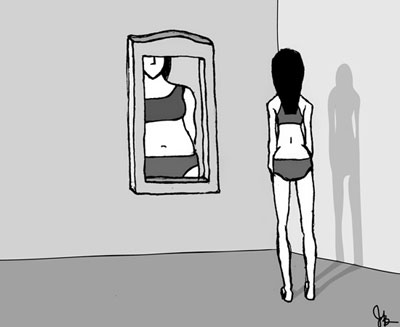 “the Body Betrayed…”
“the Body Betrayed…”
Eating Disorders (EDs) are often described as an expression of emotional infliction and confusion experienced by a person who feels forced to over consume or under consume food, thus, having a negative effect on the physical and mental health of him or her. These disorders trouble millions of people, thousands of whom will reach limits of health levels – and in some cases can be fatal. It is estimated that 5% to 7% of women in the USA are bound to be affected by such disorders, for at least once during their lifespan. Generally, EDs, despite scientific research conducted to enlighten their nature, remain a vague entity regarding their cause, prognosis and, ultimately, their outcome. Frequently, symptoms are kept in secret by patients and so it is hard to screen and treat in initial stages, when the chances for successful interventions are strong.
Causal factors
- Genetic- biological
- Psychological –social
- Environmental- cultural
- Academic pressure
- Traumatic experiences
- Bullying or teasing
Symptoms
- Considerate loss of weight
- Limitation of food intake
- Particularities in food handling
- Medication misuse (diuretics/laxatives)
- Self vomiting
- Depressive feeling/ anxiety
- Low self-esteem
- Disturbed body image
Implications
EDs affect all body systems and organs and may have profound and long term implications.
Frequent manifestations are the following :
- Growth impairment/retardation
- Low blood pressure , heart beating, as well as level of breathing
- Anemia
- Hair loss, nail fragility
- Menstruation problems or amenorrhea
- Constipation and stomach ache
- Osteoporosis/osteopenia (decrease of bone density)
There are various ED types. The two most common ones are the following:
- Psychogenic Anorexia : the patient limits food intake, aiming to significant weight loss, setting goals which are far from normal-considering one’s height, age and gender. This applies mostly to girls, during the developmental stage of adolescence, without excluding boys. Laxative behavior patterns (use of medication or self vomiting) or/and over-exercise may co-exist.
- Psychogenic Bulimia : described as excess in food consumption episodes, high in calories and in unusual combinations. Following that, it is often attempted to burn these calories through body exercise or get rid of them through the use of diuretic/ laxative medication and/or triggering vomiting. These incidents of food overload are often accompanied by feelings of shame, guilt and low self esteem.
Dealing with EDs is accomplished through a highly individualized and multidisciplinary approach (group of specialized experts involving pediatricians, psychiatrists, dieticians, family therapists etc). Therapy goals aim to the restoration of physical and mental health of patients. Efforts are made for a gradual gain of body weight and the smoothening of food habits. In the psychological sector, basic targets are psycho-social function, enhancement of self- respect, as well as restoration of body image. At the same time, necessary knowledge and information is provided, so that the patient actively participates in the healing procedure and is convinced of its necessity. Through the above strategy, the risk of relapse can be significantly reduced.
Family support is crucial throughout the process, boosting the effort to regain healthy habits and avoiding critical attitudes of the past.
References
- American Psychiatric Association (2013). Diagnostic and Statistical Manual of Mental Disorders, 5th edition, Washington DC, APA.
- Bjorge, T., Engeland, A., Tverdal, A., & Smith, G.D. (2008). “Body mass index in adolescence in relation to cause-specific mortality: A follow-up of 230, 000 Norwegian adolescents”. Am J Epidemiol, 168:30-37.


